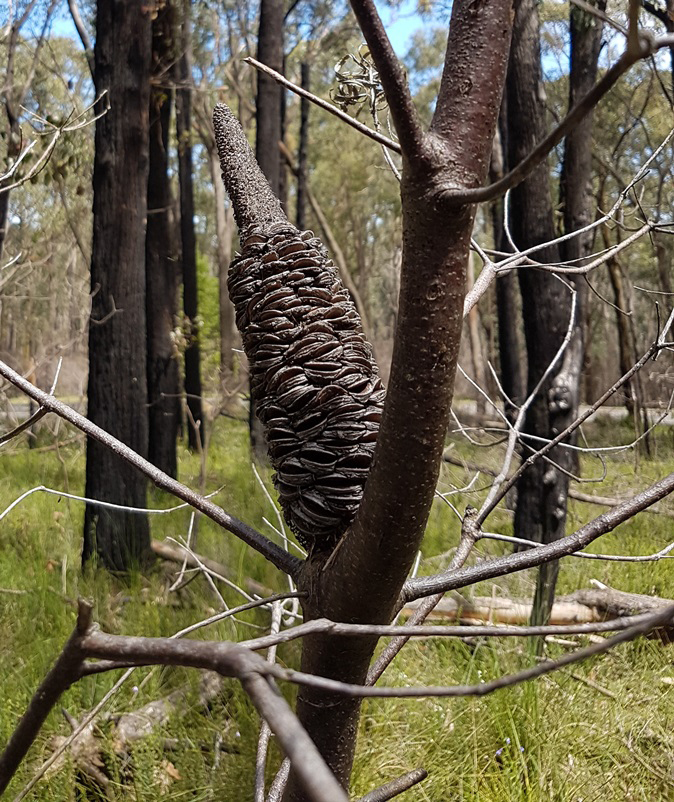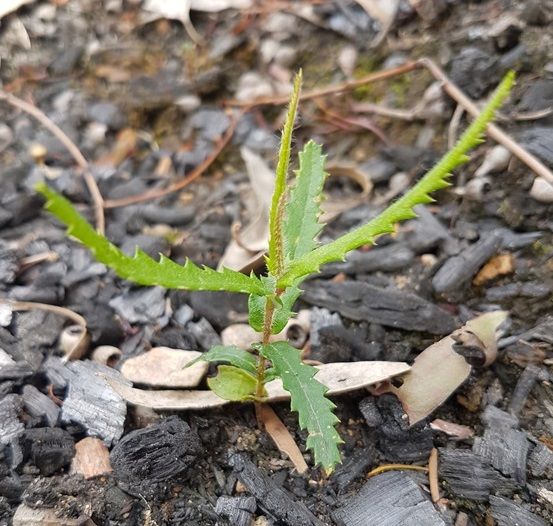ARI research on the life-cycle of Banksia cunninghamii (Hairpin Banksia) is helping maintain plant diversity in forests when applying fuel reduction burns and assessing recovery after bushfires.
Hairpin Banksia populations are vulnerable to decline if burnt too often, because plants do not resprout after fire, take a long time before producing seed, and have no soil seed banks. The interval between fires needs to be long enough for plants to mature and produce sufficient seed, and for enough seedlings to survive to replace the parent populations.
Investigations into seed production and seedling recruitment in response to fire were undertaken between 2014 and 2017, to the east of Melbourne and in East Gippsland. Results showed that:
- In populations less than ten years old, only about 40% of plants had any seed cones.
- Maximum canopy seed bank was reached between 15 and 30 years post-fire.
- Very low numbers of seedlings (~ one seedling per adult plant) were recorded at sites 18 months after fuel reduction burns.
- Differences in seedling recruitment are likely to be influenced by rainfall following fires.
During bushfires in 2019 and 2020, a large proportion of Hairpin Banksia populations in East Gippsland and Bunyip State Park were burnt. Post-fire surveys found that:
- Seedling recruitment occurred for around 90% of plants that were ten years or older, but almost no seedlings were recorded for plants that were five years or younger.
- Recruitment was also low at sites in East Gippsland that had experienced high severity fire, because seed cones were destroyed by extreme heat.


Fire history mapping indicates that a third of the distribution of Hairpin Banksia in East Gippsland had been burnt less than ten years prior to the bushfires. When considered with the lower probability of seeds and seedlings for plants less than ten years old, there are concerns that this species has declined across a large part of its range.
Guidelines for Hairpin Banksia have been produced in collaboration with burn planners in DEECA and Parks Victoria. The guidelines are based on ARI’s research findings, in the context of hotter, drier weather conditions. These include: checking cone production prior to burning; varying burn intensity; patchiness within burns; and delaying burns in drought conditions.
Funds and in-kind support were provided by DEECA's Forest, Fire and Regions Group, and Parks Victoria.
For more information contact annette.muir@deeca.vic.gov.au or visit the SWIFFT Banksia Project page (external link).
Publications
- Muir A., Amos N., Moloney P. (2024) High fire severity and frequency threaten the persistence of a widespread obligate-seeder Banksia in south-eastern Australia. Australian Journal of Botany 72, BT24048.
- Conservation challenges for Victorian Banksias: Workshop May 2020 - Muir - 2022 - Ecological Management & Restoration - Wiley Online Library
- Hairpin Banksia: A widespread plant threatened with decline by frequent fires | Australasian Plant Conservation (informit.org) ..
- Muir A., Vesk P., Hepworth G (2014) Reproductive trajectories over decadal time-spans after fire for eight obligate-seeder shrub species in south-eastern Australia. Australian Journal of Botany 62, 369-378.
Page last updated: 27/05/25